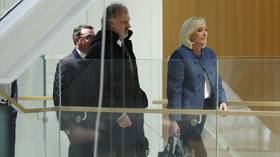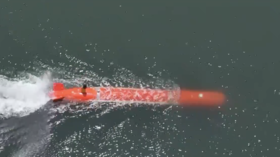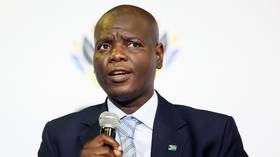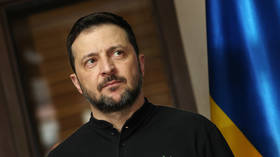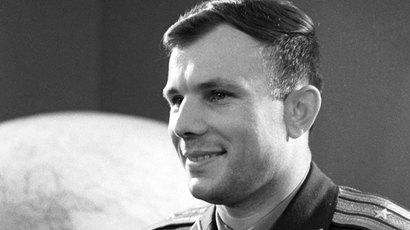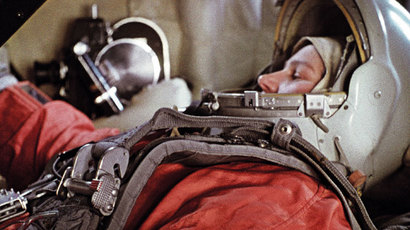Seagull in space: 50 years after first female space flight
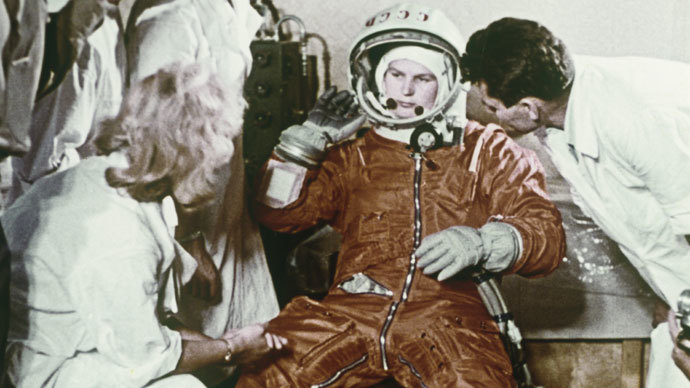
When Valentina Tereshkova, call sign Chaika (Seagull), reached orbit on June 16, 1963, she believed she had opened space up to women forever. Yet 50 years on, female cosmonauts remain an anomaly in the Russian space program.
Read the Timeline of the historic flight
Soon after the Vostok 6 mission landed after 70 hours in space –
longer than all the US astronauts put together up to that moment
– footage was beamed around the world, showing an ordinary,
smiling 26-year-old textile factory girl emerging unscathed from
her shuttle. Here, was evidence that in the Soviet Union, anyone,
not just men, scientists or pilots, could be sent on a space
mission – a feat of both egalitarianism and reliable technology.
But just as that shoot was actually a re-staging of an event that
happened 24 hours earlier, so the story of Soviet female
cosmonauts is not as straightforward as the triumphant official
history.
Soviet leader Nikita Khrushchev decided that the Russian space
program would be the first to send women to space as far back as
1961, the year Yuri Gagarin became the first man to exit the
Earth's atmosphere.
From skirts to spacesuits
Valentina Tereshkova had made more than a hundred skydives at her Yaroslavl parachuting club (which were widely promoted in the USSR, both as a pastime and a covert form of military training) when she was picked out by a Moscow Air Force officer, who inexplicably turned up for an ordinary practice.

But it was not just her parachuting prowess that led Tereshkova
to become one of five female candidates selected for the women’s
space training unit from over a thousand throughout the country.
Despite being an ordinary shop floor worker, Tereshkova was the
daughter of a war hero (her father died in the conflict with
Finland that preceded World War II), and had already made a name
for herself as a dedicated Communist activist – a must in times
when any cosmonaut became a world-famous representative of their
country.
Out of the trainees, Tereshkova was the only one without
university education, but although she wasn’t the best-qualified
candidate, her vocal leadership, dedication and forceful
personality stood out. In his diary, Colonel General Nikolay
Kamanin, the man in charge of training the team, described
Tereshkova as ‘Gagarin in a skirt’ – a model Soviet citizen –
while her chief rival, Valentina Ponomareva, was praised for
“technical competence”, but labeled as “arrogant, vain and not
averse to having a drink or a smoke”.
The year preceding the flight was not easy for Tereshkova.
In retrospect, even those who set up the training regimen at Star
City just outside Moscow, admitted that it was demanding far
beyond actual spaceflight conditions experienced by Soviet
cosmonauts on any mission. Tereshkova recalls fainting after the
centrifuge exercises, and her back covered in bloody blotches
from capillaries that burst from extreme forces.

Cosmonaut Aleksey Leonov, who was preparing for his own maiden
flight at the same time, recalls that although training would
often leave Tereshkova in tears, “she knew exactly what she
wanted from life. Tereshkova did everything she could to avoid
being dropped from the space program.”
Her fate was sealed when Khruschev himself went against the
official commission’s recommendation, and decided that a genuine
representative of the proletariat would be placed onboard
Vostok-6.
Space travel strikes back
The mission itself, done in parallel with Vostok-5, another
capsule launched two days earlier, got off to a smooth start on
the morning of June 16 (her catchphrase on take-off was “Hey
space, take off your hat, and welcome me!”).
But the reality of early space travel soon intervened.
As the hours piled up – the capsule orbited the Earth 48 times –
the bulky spacesuit began to chafe, and the pressure from the
helmet grew so strong on Tereshkova would yelp in pain. At one
point ‘Seagull’ sang songs to space control in Moscow, to stave
off agony. She was then sick in her spacesuit – she says as a
result of tinned fish and a lemon pie she ate pre-flight.
The cosmonaut did not manage to complete her planned biological
experiments, and reportedly accidentally broke two pencils given
to her for collecting observations (though Tereshkova denies the
story to this day).

But worst of all was the realization that she might not make it
back at all.
According to Tereshkova, she noticed that the orbit for her
capsule had been plotted incorrectly, “to raise the orbit,
instead of landing”, forcing her to change the instructions
from ground control.
Mission doctors, on the other hand, claimed that it was
Tereshkova’s difficult mental state following prolonged
exhaustion and powerful g-forces that was responsible for
technical difficulties ahead of re-entry. There were also
unofficial accusations that Tereshkova fell asleep during a key
point during the return.
In any case, the ship headed through the atmosphere, but just as
the hatch opened, Tereshkova broke strict instructions to keep
her head down, and was hit by her helmet, as she ejected.
Battling severe winds on the way down, a dazed but fundamentally
unharmed Tereshkova landed in the remote Altai region, where she
was quickly surrounded by curious villagers who brought her local
food as gifts.
The mission was complete.
Seagull and stardom
‘Seagull’ became an instant celebrity, flown to meet Khruschev in
Moscow as soon as she could move, and paraded in front of
television crews asking her as much about her background, as
about the nature of her mission.
Incidentally, Valentina’s mother only discovered that her own
daughter was a cosmonaut when she heard her name mentioned on the
radio. Before leaving, Valentina told her that she was training
with the national skydiving team near Moscow.
While the adulation from the public and politicians was
inexhaustible – when Khruschev heard that she was to be promoted
to air force lieutenant, he insisted that she be made captain
instead - Tereshkova received a frostier welcome back at Star
City.
The architect of the Soviet space program, Sergey Korolyov
reduced the recently landed pilot to tears during his debriefing,
in which he severely criticized her performance. Decades later,
after the collapse of the USSR, Tereshkova said that Korolyov
made her promise she would keep silent about the potentially
fatal error prior to re-entry.

Vasiliy Mishin, who would take over from Korolyov upon his death,
labeled Tereshkova a liability, saying that she had been “on the
verge of a nervous breakdown”.
Although her career as an active cosmonaut was over, her public
climb had only begun.
Within months of the landing, Tereshkova was married to fellow
cosmonaut Andriyan Nikolaev.
Many speculated that the world’s first ‘space marriage’, between
people who had not been noticeably close before the flight, was
done either at the behest of scientists, who wanted to study the
effects of space travel on reproduction, or Khruschev himself,
looking for another publicity coup (he gave Tereshkova away at
her lavish state wedding). The couple angrily dismissed the
accusations for decades.
Tereshkova gave birth to a healthy daughter a year after her
mission, but the marriage was soon on the rocks.

“Yesterday, Valentina and Andriyan were smiling and appeared
happy with each other,” wrote Kamanin months after the wedding.
“For political purposes and science their marriage might be a
success, but I am not convinced that Valentina loves him. She is
like fire, and he is like water – they are too different.”
The two drifted apart, though the divorce was only finalized in
1982 (reportedly after asking then Politburo chief Leonid
Brezhnev for permission).
Unlike many cosmonauts, who lost their status as official Soviet
deities the day the USSR collapsed, and never found a role beyond
sporadically appearing on TV as talking heads recounting their
journeys during assorted anniversaries, Tereshkova has been
continually successful in the last two decades. She is currently
a Duma deputy in Vladimir Putin’s United Russia party, and was
personally feted by the president ahead of the latest
anniversary.

But despite her personal success, Tereshkova did not open the
floodgates for a wave of female Soviet space explorers. In fact,
it could be argued that her mission convinced Soviet officials to
not launch another woman into space for years – although it is
hard to say whether their reluctance was a result of her
performance, or inherent bias.
Following Vostok-6, Korolyov famously vowed to “never send a
broad to space again”. And when Mishin, who had been skeptical
about Tereshkova from the start, became the chief of the space
program in 1966 he disbanded the women’s cosmonaut unit
altogether.
It was not until 1982 that another Soviet woman travelled to
orbit, and there have only ever been three female cosmonauts (the
latter two were both related to highly placed officials). There
is currently one female cosmonaut in training, and Russian space
doctors still openly refer to women as “badly-suited” for space
travel.
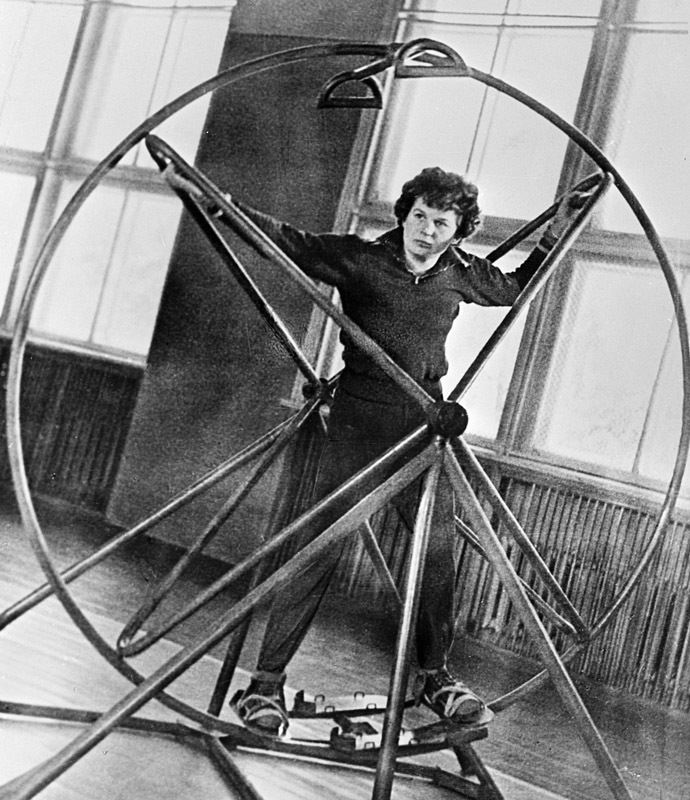
Ironically, if Tereshkova ever paved a way, it was for the space
agency on the other side of the Iron Curtain. Undeterred by their
alleged physical limitations, NASA has sent more than 40 women to
space since Vostok 6 landed in 1963.
Igor Ogorodnev, RT



